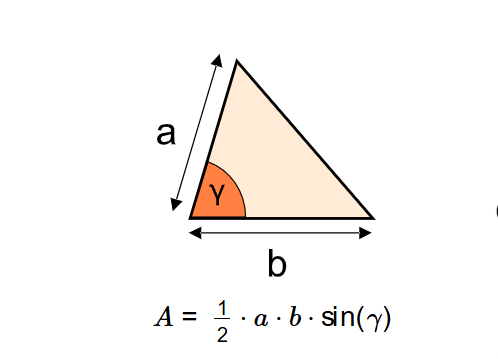1. What is an Area of a Triangle (SAS) Calculator?
Definition: This calculator computes the area of a triangle using the SAS method (two sides and the angle between them). Given sides \( a \) and \( b \), and the angle \( \gamma \) between them, it calculates the area. The calculator supports length units (mm, cm, m, in, ft, yd) and area units (mm², cm², m², in², ft², yd²), defaulting to m for inputs and m² for area.
Purpose: It aids in geometry education and practical applications by calculating the area of triangles, useful in fields like architecture, engineering, and design for triangular shapes.
2. How Does the Calculator Work?
The calculator uses the following formula:
- Area: \( A = \frac{1}{2} \cdot a \cdot b \cdot \sin(\gamma) \)
Steps:
- Input the lengths of sides \( a \) and \( b \), with units defaulting to m.
- Input the angle \( \gamma \) in degrees.
- Select the desired unit for the output area (defaulting to m²).
- Validate inputs: ensure sides are positive and the angle is between 0° and 180°.
- Convert side lengths to meters for calculation.
- Compute the area using the SAS formula.
- Convert the area to the selected output unit.
- Display the result to 4 decimal places.
3. Importance of Triangle Area (SAS) Calculations
SAS triangle area calculations are essential for:
- Geometry: Determining the area of a triangle when two sides and the included angle are known, a common scenario in trigonometric problems.
- Land Surveying: Measuring triangular plots of land where two sides and the angle between them can be directly measured.
- Engineering: Analyzing triangular components in structures, such as trusses, with measurements in different units like centimeters or feet.
4. Using the Calculator
Examples:
- Example 1: Sides \( a = 3 \) m, \( b = 4 \) m, \( \gamma = 30^\circ \), Area in m²
Area: \( A = \frac{1}{2} \cdot 3 \cdot 4 \cdot \sin(30^\circ) = \frac{1}{2} \cdot 3 \cdot 4 \cdot 0.5 = 3.0000 \) m².
- Example 2: Sides \( a = 50 \) cm, \( b = 60 \) cm, \( \gamma = 45^\circ \), Area in cm²
Convert to meters: \( a = 0.5 \) m, \( b = 0.6 \) m
Area: \( A = \frac{1}{2} \cdot 0.5 \cdot 0.6 \cdot \sin(45^\circ) \approx 0.1061 \) m² = 1061.0000 cm².
- Example 3: Sides \( a = 2 \) ft, \( b = 3 \) ft, \( \gamma = 90^\circ \), Area in ft²
Convert to meters: \( a = 2 \cdot 0.3048 = 0.6096 \) m, \( b = 3 \cdot 0.3048 = 0.9144 \) m
Area: \( A = \frac{1}{2} \cdot 0.6096 \cdot 0.9144 \cdot \sin(90^\circ) \approx 0.2787 \) m² = 3.0000 ft².
5. Frequently Asked Questions (FAQ)
Q: What does SAS mean in triangle area calculation?
A: SAS stands for Side-Angle-Side, meaning the area is calculated using two sides of the triangle and the angle between them.
Q: Why do inputs and outputs default to m and m²?
A: Meters (m) and square meters (m²) are the default units to provide a standard metric base, ensuring consistency in calculations, but you can convert to other units as needed.
Q: Why must the angle \( \gamma \) be between 0° and 180°?
A: The angle \( \gamma \) represents the included angle between the two sides in a triangle, which must be between 0° and 180° to form a valid triangle.
Area of a Triangle (SAS) Calculator© - All Rights Reserved 2025
 Home
Home
 Back
Back
